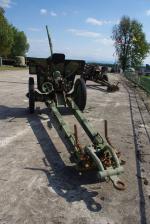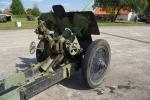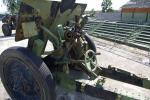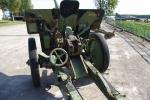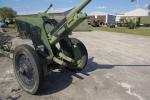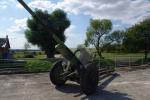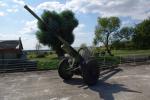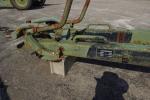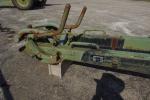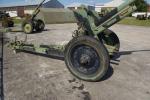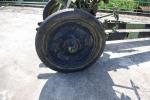Canon 76 K/36 "Rotanhäntä" Musée Abri d'Hatten
English Translation
Merci à Christian Adam pour les photos
Texte traduit du site Jaeger.Platoon
Historique Voir ICI
History Click HERE
76 K/36 "Rotanhäntä"
traduction du texte anglais de Jaeger Platoon
Ce canon est pièce exceptionnelle parmi les canons de campagne léger utilisés par l'armée finlandaise, Il fut introduit au début de la 2e Guerre Mondiale et fut utilisé jusqu’à la fin de celle ci.
Ce canon est le fruit des études soviétiques des années 1930 afin de développer une game de canon de 76,2 mm
Le projet a été lancé en 1934, les premiers prototypes ont vu le jour en 1935 et la production a suivi en 1936. La conception et les caractéristiques, indiquent que ce canon était à l'origine destiné à être utilisé aussi comme arme anti-aérienne même si l’affut n'était pas vraiment approprié pour une telle utilisation. Le canon de la production en série n’avait pas aussi de système de visée pour une utilisation Anti aérienne. Le mécanisme de recul sous le canon très long et mince, entrainé son surnom de Rotanhäntä" (queue de rat). Qui lui a été donné par les soldats finlandais
Ce canon avait d'excellentes propriétés balistiques) Il avait des roues séparées de telle façon que seulement deux soldats étaient nécessaires pour la mise en batterie .Le bouclier a sa partie supérieure repliable. Le système de visée ne fut cependant jamais trop pratique :.
Les munitions étaient typiques de type d’arme HE- une charge propulsive deux tailles et les Soviétiques utilisaient ces armes comme des armes antichar en cas de besoin, aussi ils avaient de munitions Anti char.
Le seul problèmes dans la conception se trouve au niveau du train de roulement et de l affut
Il possède un train de roulement avec pneus en caoutchouc (certains ont également été fabriqués avec des roues en bois, mais aucun d'entre eux n’a été capturé par les Finlandais ont été Sa faible garde au sol fait que son remorquage en tout terrain est très difficile La vitesse maximale de remorquage n'était que de 18 km / h.
La culasse semi-automatique avec coulissement vertical du bloc de culasse permis une cadence de tir raide (12 - 15 coups / minute , mais certaines sources vont jusqu’à 25 coups / minute)
Mais ce canon a été rapidement remplacé dans l’arsenal militaire soviétique par le canon de campagne de 76 mm F-22USV.
Au cours de la 2e Guerre Mondiale les Allemands ont capturés ces armes en grand nombre et les ont trouvés excellents
aussi il furent modifiés et purent utiliser des munitions plus puissantes et ont aussi mis a point une obus anti car le PzGr. 39 , APCR (40 PzGr. Ainsi qu’une gamme de munitions HEAT et HE pour eux. Il fut alors utilisé comme canon anti char par les Allemand et Roumains
Le canon peut être tracté en version hippomobile ou motorisés La vitesse maximale de remorquage motorisé était de 30 km / h. Lorsque qu’il est utilisé en version hippomobile il est utilisé avec avant-train, qui emporte 24 coups
L’ armée finlandaise capturent 37 canon 76K/36 canons (pour la plupart en rive nord du lac Ladoga et ils seront immédiatement utilisés pendant la guerre d’Hiver. La grande majorité des armes saisies ont été utilisés par l'artillerie de campagne, mais il y aura aussi quatre canons en service avec l'artillerie côtière
Lors de la Guerre de Continuation 49 seront capturés . Les Finlandais ont rarement utilisé la capacité antichar, de cette arme, qu’il ont été utilisé comme des canons de campagne ordinaire. Seul le 3e Bataillon du 4e Régiment d'artillerie a essayé de l'utiliser comme arme antichar contre les chars lourds soviétiques (probablement KV-1). Les Soviétiques ont réussi à capturer les armes à feu qui avait toutefois endommagé le char, mais les Finlandais le reprennent quelques jours plus tard.
Les Soviétiques ont réussi à reprendre quatre canons près de Viipuri durant la Guerre d’Hiver.
Deux canons seront été perdus en 1941 dans le secteur Kiestinki et deux autres appartenant à Brigade côtière du lad Ladoga durant l'été 1944.
Après la 2ème guerre mondiale armes sont restées et mises en réserve jusque dans les années
Seul les achats importants des ex pièces d'artillerie de l armée est-allemand au début de 1990 a permit à ces canons d’être
Caractéristiques
Calibre:76,2 mm x 385 R
Poids 1.6 Tons
Longueur Calibre:L/51,1
V° :424-625 m/sec
Azimut:3 degrés
Elevation:- 5 degrés, + 75 degrés
Portée Max 13,6 km
Poids Munition 6,4 kg (HE)
Types de munition type:HE, AP, AP-T, APHE-T, HEAT (1944), HEAT-T (1944), shrapnel, incendiary
76 K/36 "Rotanhäntä"
This gun was exceptional among light field guns used by Finnish Army, as it was brand new design still during WW2. The gun resulted from Soviet efforts of 1930's for developing new 76.2-mm field gun, which would have longer range. The project was begun in 1934, the first prototypes saw light in 1935 and the mass production followed in 1936. The design had characteristics, which indicated that the gun was originally intended to be used also as antiaircraft-gun, even if the gun carriage wasn't really suitable for such use. The mass production gun also didn't have sights for AA-use. Recoil mechanism was under the very long and thin barrel, which inspired Finnish soldiers to nickname the gun as "Rotanhäntä" (Rats tail). Gun had excellent ballistic properties, split trail, wheels with sponge rubber tires (some were also manufactured with wooden wheels, but none of them were among those captured by the Finns) and gun shield with foldable upper section. The aiming system however wasn't too practical: It had separate wheels for elevation and traverse located in such a manner that two soldiers were needed to use them, which made aiming the gun fast more complicated than necessary. The ammunition was typical cartridge of fixed ammunition type and gun had the typical dial sight. HE-shells came with two propellant charge sizes and as the Soviets also used these guns as antitank weapons when needed, they had also AP-ammunition for them. Problems of the design were painfully obvious when it came to towing the gun. Very low ground clearance made towing the gun in terrain difficult and maximum towing speed was only 18 km/h. Semiautomatic breech with vertical sliding breech block allowed good rate of fire (12 - 15 shots/minute have been mentioned, but some sources claim even 25 shots/minute could be achieved) when it worked. Soviet military wasn't happy with the gun and further development lead to introduction of 76-mm F-22USV field gun. During WW2 the Germans captured these guns in large numbers and found them so good that they not only took the gun in large scale use, but modified the to use more powerful ammunition and also developed AP (PzGr. 39), APCR (PzGr. 40), HEAT and HE-ammunition for them. In German use the gun achieved reputation especially as antitank gun and was used in both German and Romanian tank destroyers. The gun could be either horse-towed and motor-towed. Maximum speed in motorised towing was 30 km/h. When horse-towed the gun was used with limber, which carried 24 shots.
Also Finnish Army found captured 76 K/36 guns very useful and pressed them immediately in use already during Winter War. The great majority of captured guns were used by field artillery, but four guns also saw service with coastal artillery during Continuation War. During Winter War 37 guns were captured (most of them in north side of Lake Ladoga) and 49 were captured during Continuation War. Finnish soldiers find the gun otherwise excellent, but the semi-automatic breech system with vertical sliding breech block was unreliable and malfunctioned every now and then. The Finns seldom used the antitank-capacity, which these guns possessed, instead they were used like ordinary field guns. Soviets recaptured four guns because of carelessness near Viipuri during Winter War. Two guns were lost year 1941 in Kiestinki sector and another two belonging to Ladoga Coastal Brigade in summer of 1944. Not included to these numbers is one gun, which 3rd Battalion of Field Artillery Regiment 4 tried to use as antitank gun against Soviet heavy tank (presumably KV-1). The Soviets managed to capture the gun after it had been damaged by the tank and gun crew had abandoned it, but the Finns re-captured it only few days later.
After WW2 the guns remained warehoused for reserves well to 1990's. Only large purchases of more modern ex East-German artillery pieces in early 1990's finally retired them.Same ammunition was used for antitank use in all 76,2 mm x 385R calibre field guns by the Finns, but some of the details (such as muzzle velocities) varied. 76 K/36 had the longest barrel from all 76,2-mm field guns used by the Finns, which is quite evident in muzzle velocities of AP-ammunition. Information about special ammunition for this gun:
Finnish use: 37 captured during Winter War and 49 captured during Continuation War. Used by Finnish field artillery during Winter War and Continuation War
Technical data
Calibre:76,2 mm x 385 R (fixed ammunition)
Weight 1.6 Tons
Barrel length:L/51,1
Muzzle velocity:424-625 m/sec
Traverse:3 degrees
Elevation:- 5 degrees, + 75 degrees
Max. range:3,0-13,6 km
Ammunition weight:6,4 kg (HE)
Ammunition types:HE, AP, AP-T, APHE-T, HEAT (1944), HEAT-T (1944), shrapnel, incendiary






